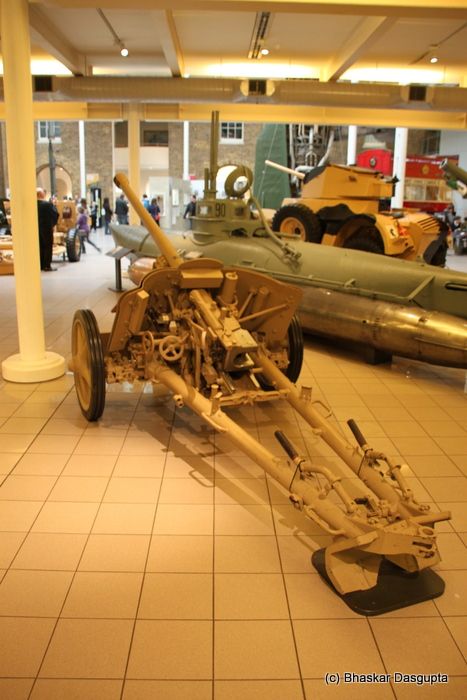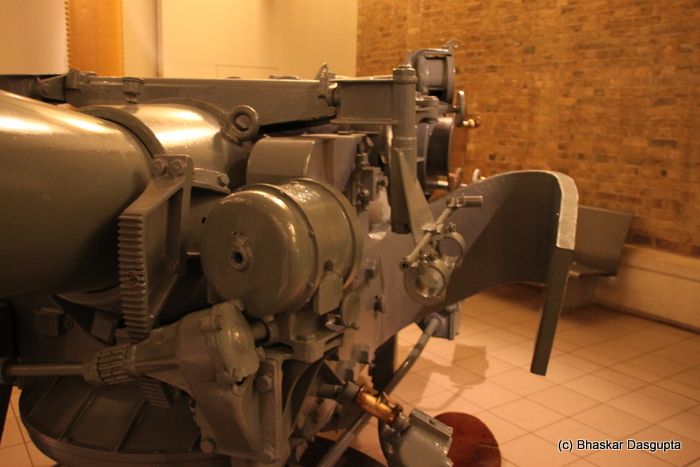This is the sixth in the series of photo essays of the Imperial War Museum. I am still on the first floor and my eyeballs are on stalks, swivelling around in an absolutely amazed manner. The stuff here is absolutely brilliant. Brings my childhood back when I would be sneaking around reading commando comics.
This is an Italian Human Torpedo. A one man unit.
Can you imagine being inside one of these tiny cabins? You alone? In that tiny space? With condensation dripping down the Perspex windows? 
That’s the only view you will have, looking up through the Perspex into the muddy cloudy waters of the North Sea or in the Med. 
You tap the dials to make sure the direction or speed is good. You aim for the vessel, then pop out and let the torpedo go to the target. 

This is a German Beiber. A one man submarine with a torpedo attached to it on the side. See the gleaming unit on the right? That’s the torpedo. 
A tiny conning tower with a periscope and exhaust pipe

Another view of the midget submarine. 

This unit was found off Dover. The submariner had died because of carbon monoxide poisoning as he made a mistake with the exhaust piping. The view from these tiny windows would have been the last sight that these poor sailor would see before the lights close out. 

This oddly shaped model is the Little Boy. Hard to imagine that this gave rise to the nuclear bomb age. This is the sucker which killed Hiroshima. You know, I stood in front of this model. Yes, I knew this was a model but I would have expected to feel something in here. But nothing. No talk, no feeling, no emotions, no nothing. Maybe I was expecting too much, but nothing at all. Maybe I am getting too accustomed to hearing voices in my head, lol. 




This is a German U Boat Submarine Gun. In WW1. 10.5 cms. These guns were used to attack unarmed merchant ships thereby saving valuable torpedoes for naval ships. Can you imagine? boiling out of the conning tower, flinging aside seaweed fronds, taking the barrel cover away and then firing in the loud flat manner at the ship. 

This is a German 5 cm anti tank gun. One of the most successful pieces in the German armoury. Low silhouette, tungsten cored ammunition, extremely accurate, very mobile and extremely dangerous. 
Small unit, no? 
Doesn't look dangerous at all, does it?
Wander around to the back and you look at the hood. Shining brass and grey painted steel. 
And then you look through the aiming reticules. Did you know this gun was on the HMS Lance? And it fired the first shot from a British Ship in World War 1? 
This is a British 5.5 Naval Gun. That’s good, but why is it famous? 
This is Jack Cornwell. A boy, first class. You cant get any more junior than that. 
HMS Chester, that’s where the gun was placed, 
His job was to adjust this brass sight. Based upon the commands of the gunnery officer. 
On May 31, 1916, HMS Chester went into battle in the Battle of Jutland. 
His gun took a direct hit from German gunfire. Everybody was killed or injured. John was hit in the chest by a shell fragment but he stayed on duty. 10 days later, he died from his wounds. For his awesome bravery, he was awarded the Victoria Cross, the second youngest man to win this award. The boy who stood on the burning deck indeed. My Ma told me this story of the boy who stood on the burning deck and it made a huge impression on me. And now I am faced with a boy man who did exactly that.




No comments:
Post a Comment